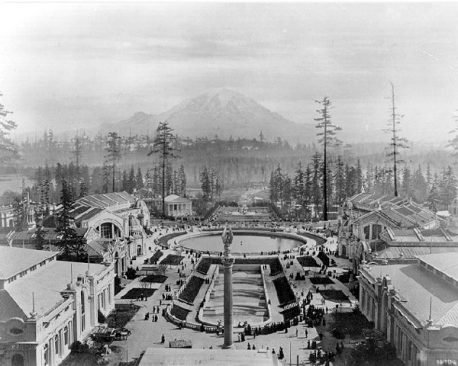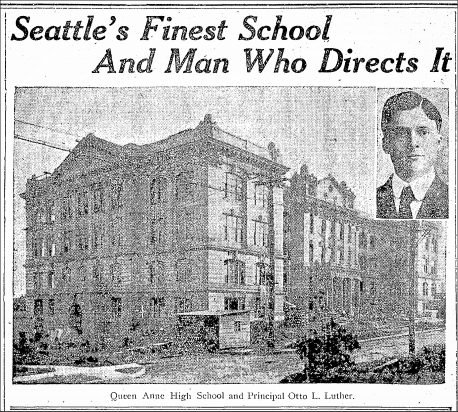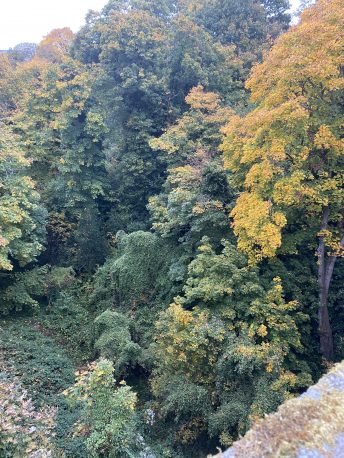This Week in Queen Anne History
Queen Anne residents enjoying their coffee over the October 23, 1910 issue of The Seattle Sunday Times read that a site in their neighborhood was being eyed for a huge Seattle stadium, complete with an architectural drawing of the proposed facility and an estimated $150,000 price tag. Many of those readers were probably as surprised by the news as I was after discovering this bit of long-forgotten neighborhood history 111 years later. The stadium was the dream of Otto L. Luther, who in 1910 was the 28-year-old principal of the newly-opened Queen Anne High School. Luther’s idea was bold and ambitious, very much like the city itself in 1910.
The plan called for an open-air, multi-use stadium to be constructed within the natural contours of Wolf Creek Ravine, a deep gully on Queen Anne’s north side that interrupts the path of 3rd Avenue North between Boston and Raye streets. The stadium was to be bordered by McGraw Street at its south end and by 2nd Avenue North and Nob Hill Avenue along its west and east sides, respectively. The architect’s drawing includes an auto drive approach to the facility underneath a bridge at McGraw Street, where there was no bridge in 1910. Today’s McGraw Street Bridge was completed in 1936 and replaced a timber-trestle bridge that was built across the ravine in 1914.
Luther’s plan for the facility seems a bit on the absurd side today; and lack of any mention of the plan in the Times subsequent to its announcement suggests that the city quashed it immediately. But understanding Luther’s enthusiasm for his audacious proposal requires a deeper dive into the zeitgeist of early twentieth century Seattle. Because the man and his dream fit squarely therein.
Just twenty years before Luther’s proposal, Seattle’s ascension to premier city of the Pacific Northwest was in no way a foregone conclusion. In fact, Tacoma had been giving us quite a run for our money, having been chosen as the terminus of the Northern Pacific Railroad in 1873. The line reached Tacoma via Portland and the Columbia Gorge in 1884, with an unreliable spur line connection to Seattle.
Seattle’s fortunes began to turn in 1889, when it was chosen as the West Coast terminus of the Great Northern Railroad. Railroad speculation and job opportunities in the rebuilding after the great fire of 1889 contributed to a population jump from 3,533 in 1880 to 42,800 by 1890. The Great Northern line to Seattle was completed in 1893, the same year that a financial panic plunged the city, and the nation, into an economic depression.
The discovery of gold along the Klondike River in the summer of 1897 lifted Seattle out of the depression in short order. Savvy city boosters recognized that the smart money wasn’t in quitting their jobs and heading to the Yukon (as Seattle’s mayor, William Wood, did via telegraph from a conference in San Francisco); it was in luring the money here. They aggressively marketed Seattle as the jumping-off point for prospectors to purchase the massive amount of supplies required for entry to the Yukon territory and successfully lobbied the government for an assay office, assuring that a good deal of the cash exchanged for gold would be spent here as well. We got them coming and going, so to speak. By the turn of the century, Seattle had firmly established itself as the premier city of the Pacific Northwest.
Bold and ambitious promotion had made Seattle a success, and that lesson stuck. Nothing the city dreamed or did during the first decades of the twentieth century was small. Massive regrading and filling projects reshaped the landscape from 1897 until completion in 1930. The city hired famed landscape architecture firm, the Olmsted Brothers, in 1903 to create a comprehensive parks and boulevard plan. They returned in 1907 to design the grounds for the 1909 Alaska-Yukon-Pacific (AYP) exposition. The AYP took place on the University of Washington’s new campus on Portage Bay, to which it relocated from downtown in 1895. The hugely successful exposition celebrated Seattle’s gold-rush prosperity and promoted the city as the gateway to Alaska and the Pacific Rim nations of Asia.
The Lake Washington Ship Canal and locks were built by the federal government between 1911 and 1917, with the city undertaking construction of bridges and other related improvements. The Bogue Plan, which called for a civic center in the Denny regrade area and massive transportation infrastructure improvements, including a train tunnel under Lake Washington, was rejected by voters in 1912. Although the Bogue Plan was not embraced, the ambitious spirit behind it was very much in keeping with that of the city and its proud residents.
Otto Luther’s dream of a giant sports facility in Queen Anne seems less outlandish against the backdrop of his times. The Seattle Daily Times ran an article in February 1910 profiling the progressive young principal and the beautiful new building, which they dubbed Seattle’s finest school. Luther discussed the importance of excellent facilities and his view that the new school exemplified the democratization of high school education, putting it within reach of everyone and being what he called, “the people’s college.”
The school was indeed an outstanding and beautiful facility for learning, particularly considering that the parents of those first students were likely educated in one-room schoolhouses. But in its early years, Queen Anne High School lacked an athletic field. None of the six high schools in the Seattle district at the time had a grand, multi-sport venue such as the one Luther proposed. Students practiced in parks and used college arenas for games and track meets, when available.
The lack of a Seattle high school stadium was a situation that Luther described as an emergency in the letter he submitted to the Municipal Plans Commission along with his stadium proposal. But he made no mention of this problem or how it might be addressed in the Times profile of him and the new school just 9 months earlier. So, what happened to inspire this bold vision? It appears his inspiration was partly driven by that old rivalry with Tacoma. The Times article cites the construction of a high school stadium in Tacoma as increasing the urgency of Seattle’s need for such a facility.
Tacoma High School opened its stunning open-air stadium, built in a bowl overlooking Commencement Bay, in the Spring of 1910. The stadium gained nationwide acclaim almost immediately and was such a source of pride for Tacoma that the school’s name was officially changed from Tacoma High School to Stadium High School in 1913. The stadium-opening event was a state championship track meet in June, 1910; and one of the athletes who qualified was from Queen Anne High School. Luther was certainly aware of the stadium, but the track meet was likely his first time being there.
Anyone who has ever been to Stadium High School can imagine just how awestruck and inspired young Luther must have been at the sight of the imposing chateau-style school building perched above a state-of-the-art sports facility in a breath-taking natural setting. Queen Anne and the Seattle school district had their beautiful new building; but how could they not have a stadium befitting a city of their elevated stature? Luther wanted one even bigger and better for Seattle, and felt that that nuisance of a gully cutting through Queen Anne’s north side was the perfect setting.
Luther argued that the location was at the center of the city’s population and easily accessible to students from all Seattle high schools. He pointed to the many streetcar lines that came near the site, suggesting that only a small spur would be needed to complete the connection. The architect’s plan shows 40 tiers of seating rising 55 feet with a capacity of 33,200. That would have bested the 31 tiers of seating and 32,000 capacity that Tacoma’s stadium originally boasted (its capacity was decreased in subsequent alterations and restorations of the facility). He listed many potential uses for the venue beyond sports, including theatrical performances and evening concerts. He imagined 30,000 Seattle schoolchildren gathered on the field forming a living flag to greet the president on his next visit. Luther concluded his letter with an appeal to Seattle’s faith in aggressive self-promotion:
In these “all together for Seattle” days, when men of vision urge a million for advertisement, would it not be most profitable advertising to use but one-sixth of this sum to build a magnificent structure like this that would serve all of Seattle and serve to advertise Seattle all over the country?
So why didn’t Luther’s plan gain any traction? It is reasonable to assume that residents in the immediate vicinity of the proposed site were not keen on the idea of having a high-capacity, high-traffic venue in their backyards, an understandable NIMBY position. City-funded improvements to Queen Anne were largely driven by citizen community club members lobbying the city; and at the time of Luther’s proposal, their interest was intensely focused on completion of the Queen Anne Boulevard system recommended by the Olmsted Brothers a half decade earlier. Beyond this, federal funding had finally come through to complete the long-awaited Lake Washington Ship Canal with passage of the 1910 Rivers and Harbors Act. The western outfall of Lake Union, the view to which Luther’s stadium would have opened up, was about to become a massive and long-term construction site with the digging of the canal, eventual construction of the Fremont Bridge and construction of the temporary Stone Way Bridge that served through the canal building years.
The ambitious young principal must have been deeply disappointed that the city and the Queen Anne community did not embrace his plan. But they certainly appreciated and embraced him as an advocate, leader and mentor to the tens of thousands of students whose lives he touched over his 42-year career as the principal of Queen Anne High School. He took his position as a leader of young minds very seriously, and proudly boasted about his students who went on to achieve great success, of which there were many. He was named Man of the Year by the Queen Anne Lion’s Club in 1948. They described him as having a stern and gruff exterior that had students “quaking in their loafers and bobby socks,” but having a ready wit and deep loyalty to his school. When he retired in 1951, several former Queen Anne High School athletes formed the Otto L. Luther Fan Club, a testament to his belief in the importance of physical fitness to developing strong minds and bodies -- a belief that certainly inspired the vision of a grand stadium when he looked down at the gully on the north side of the hill.
In Luther’s day, Wolf Creek Ravine was considered a danger to children and the growing number of automobile drivers in the neighborhood. It was filled from Newton Street to Boston Street (over which a 50-foot-high timber trestle carried traffic), and Boston Street paved in 1934. The portion from Boston Street to Lynn Street was filled with earth excavated for the 1962 World’s Fair and eventually turned into a p-patch. The remainder of the ravine is reserved as a natural area and can be seen from a dizzying height over the railing on the north side of the McGraw Street Bridge. After learning about Otto Luther’s dream for the site, I doubt I’ll ever be able to walk or drive across the bridge again without imagining the sound of 33,000 cheering fans rising from below.








